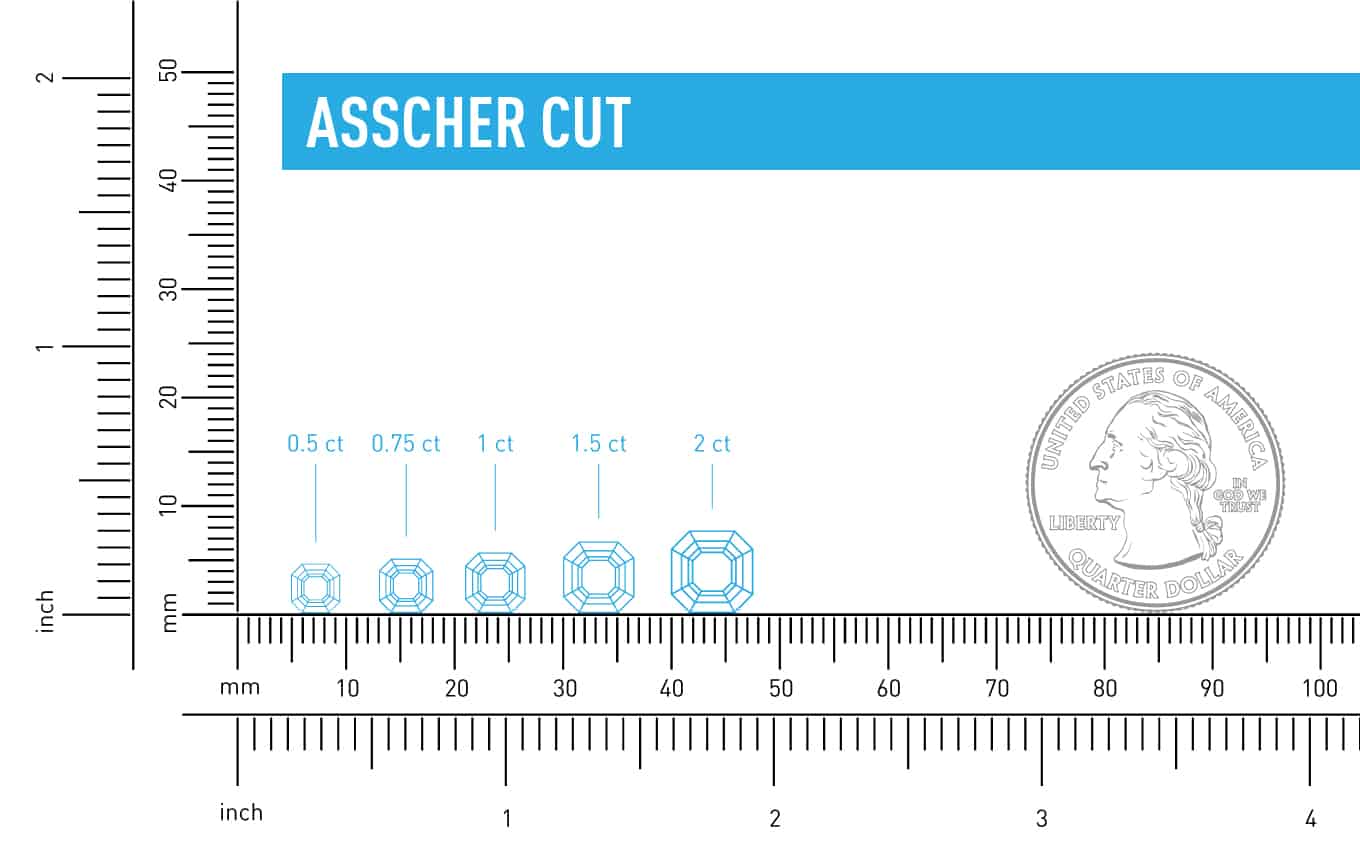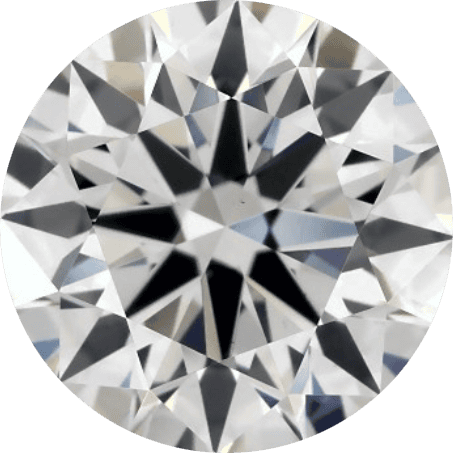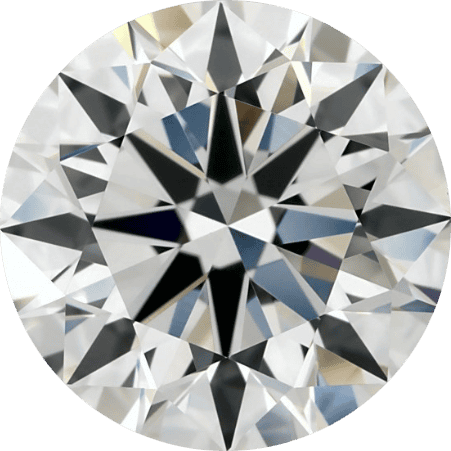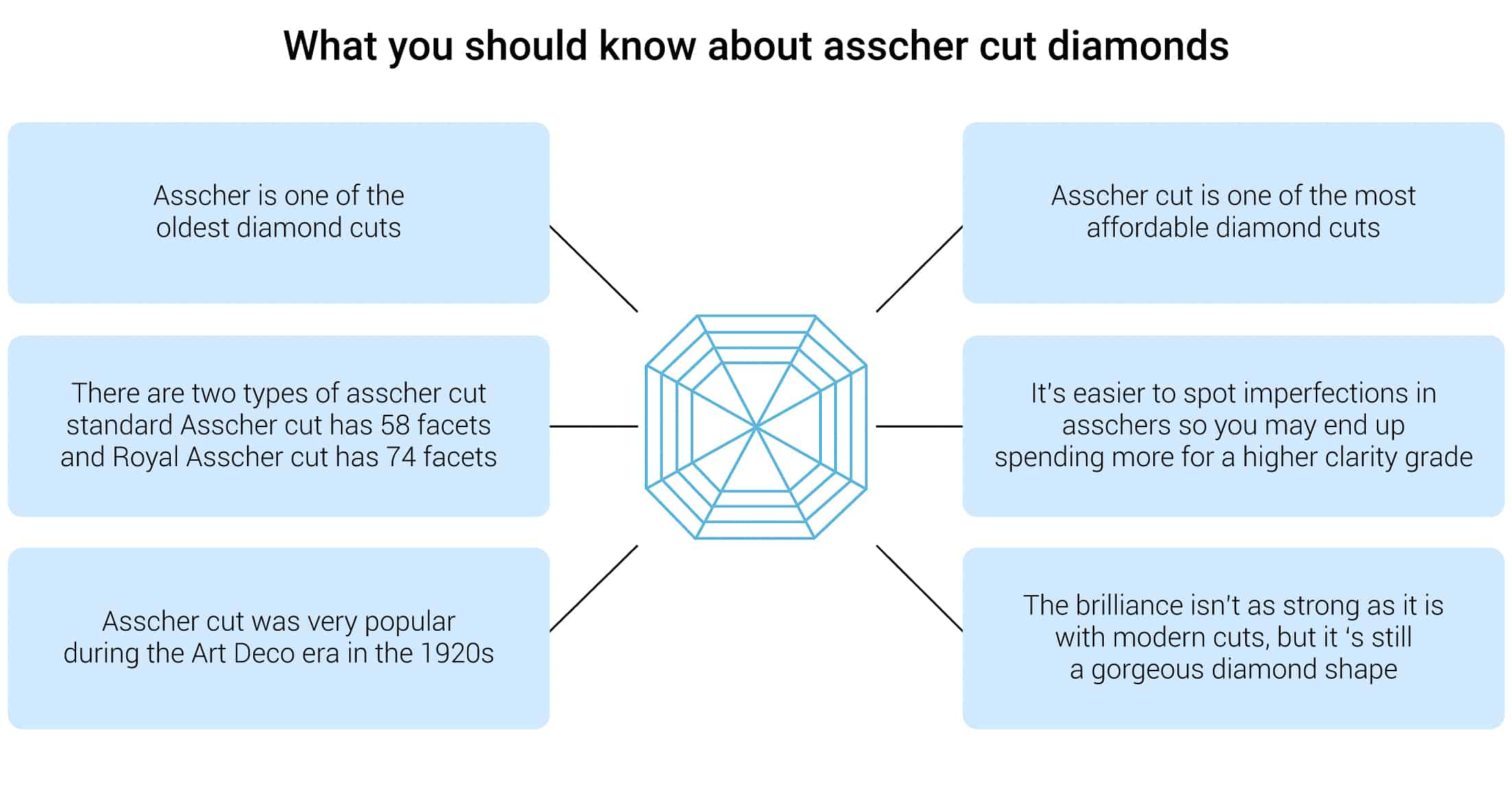We are reader-supported. Buying through any red colored link on our site may earn us commissions. Learn More.
Up to 30% off engagement rings and select jewelry at James Allen!
The Asscher cut diamond is a distinctive choice, characterized by its square shape with deep, layered facets. While it shares some similarities with the emerald cut, its unique octagonal design sets it apart. There are two primary variations: the standard Asscher and the Royal Asscher.
Asscher cuts tend to reveal imperfections more than other shapes, so you may opt for a higher clarity grade to ensure your diamond is eye-clean. Since the majority of the rough stone is maintained in the cutting process, the Asscher cut is generally less expensive than other fancy-shaped diamonds. A one carat asscher cut will cost you $3,800 if you follow our guidelines.
Below we discuss everything you need to find yourself the perfect asscher cut diamond.
Here’s what we’ll cover in this article:
What is an asscher cut diamond?
Why should I choose an asscher cut diamond?
What is the difference between an asscher cut and a princess cut diamond?
What is the difference between an asscher cut and an emerald cut diamond?
Is an asscher cut more expensive?
How do you pick an asscher cut diamond?
– Asscher cut: Color
– Asscher cut: Clarity
– Asscher cut: Cut quality
What setting style should I choose for an asscher cut diamond?
FAQs about asscher cut diamonds
Why you should trust us
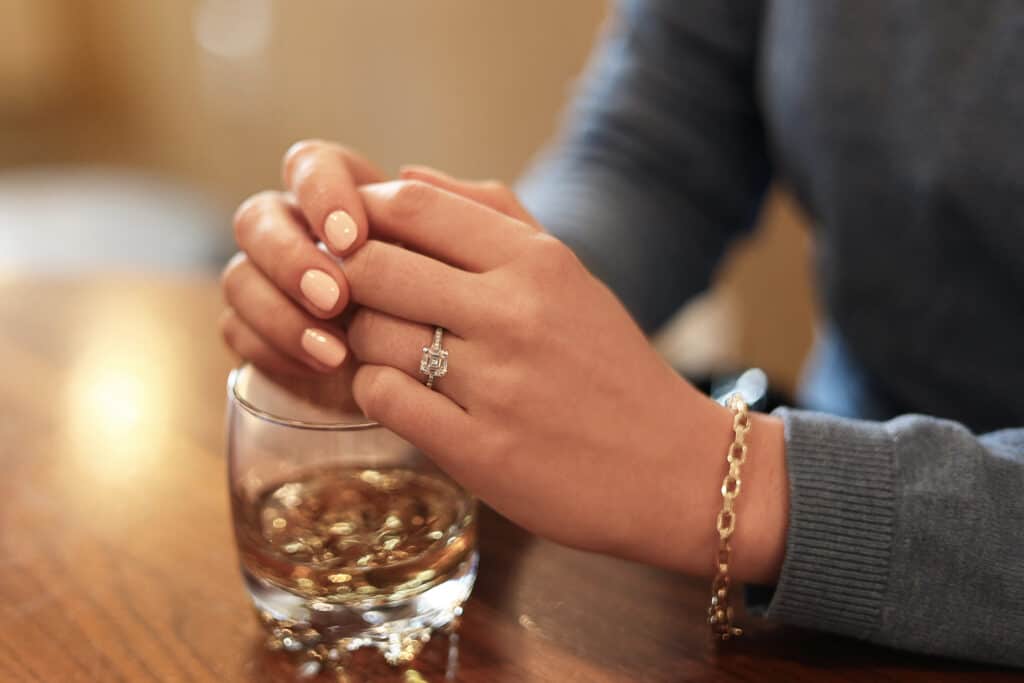
What is an Asscher Cut Diamond?
An asscher cut diamond is an octagonal diamond with a square shape and layered facets. The asscher cut features a deep pavilion and high crown—offering brilliance and its signature appeal. There are two types of asscher cuts. There’s the standard asscher cut and there’s the Royal asscher cut. Both were created by the Royal Asscher company.
Unique Features of Asscher Diamonds
The straight-edged facets of the asscher diamond (like this gorgeous 1ct from James Allen) give it a unique, clean look. Sometimes referred to as a “square emerald”, both shapes carry a signature point of difference to brilliant cuts, with their features reminiscent of the Art Deco era.
Asscher diamonds usually have 58 facets, the same as a round brilliant. The arrangement of these facets however gives its uniquely vintage appearance, and a “hall of mirrors” look.
The shape is the other defining characteristic of asscher diamonds. The shape is equal in length and width, as a square would, yet with angled corners that give it an octagon shape. The result is something in between that of a round cut and a perfect square like a princess cut.
Below you can check out the size differences of an asscher cut between the different carat weights compared to a US quarter.
History of the Asscher Cut Diamond
“The asscher cut was first developed in 1902 by Joseph Asscher, and became popular in the Art-Deco movement and following World War I.” “Joseph Asscher saw an opportunity to better use rough diamond crystals to his advantage, therefore retaining more weight than the stone could with other styles of cutting.” Gemological Institute of America (GIA)
After being produced in 1902 by the Asscher Brothers of Holland, the asscher shape regained popularity in 2002 after its one-hundredth anniversary and a small change to the cut technique.
The original asscher cut design has 58 facets and was never patented. It is this design – the square emerald cut – that is referred to universally as the “asscher cut.” The following is a quote from the Royal Asscher Website regarding this confusion:
The Royal asscher cut has a high crown and 74 facets – whereas the modern square-emerald cut, and the original asscher both have 58 facets.
Today the asscher family name is often used as a commodity term for square-emerald cuts. It is obvious why companies want to use the world-renowned asscher name.
Diamonds such as asschers and emeralds are among the oldest of diamond cuts. Compared to brilliant cuts (like the princess and round brilliant), asscher cuts came about earlier, due to reduced precision required in the cutting process.
Reasons to Choose an Asscher Cut Diamond
Many people are enamored by the asscher cut’s clean, elegant look. The long, rectangular facets allow for a lot of light to enter the diamond and to give off large flashes.
Most people go with an asscher cut diamond for its vintage appeal. This style of diamond was most popular during the Art Deco era of the 1920s, and today’s asschers have an allure that harks back to that time.
If you’re in the market for a step cut diamond, the asscher is a perfect choice. Alternative options in the step cut category are emerald and baguette diamonds.
Asscher Cut Engagement Rings for Inspiration (Click a Ring for More Information)
The Most Popular Diamond Shapes
Since the asscher cut isn’t the number one people’s choice when buying a diamond (the round cut diamond is), it gives you the perfect opportunity to be different. There are many more shapes that are popular with people looking for a more unique look. We dedicated a whole page to all the diamond shapes you may want to consider and it’s definitely worth checking out.
Diamond Shape Chart
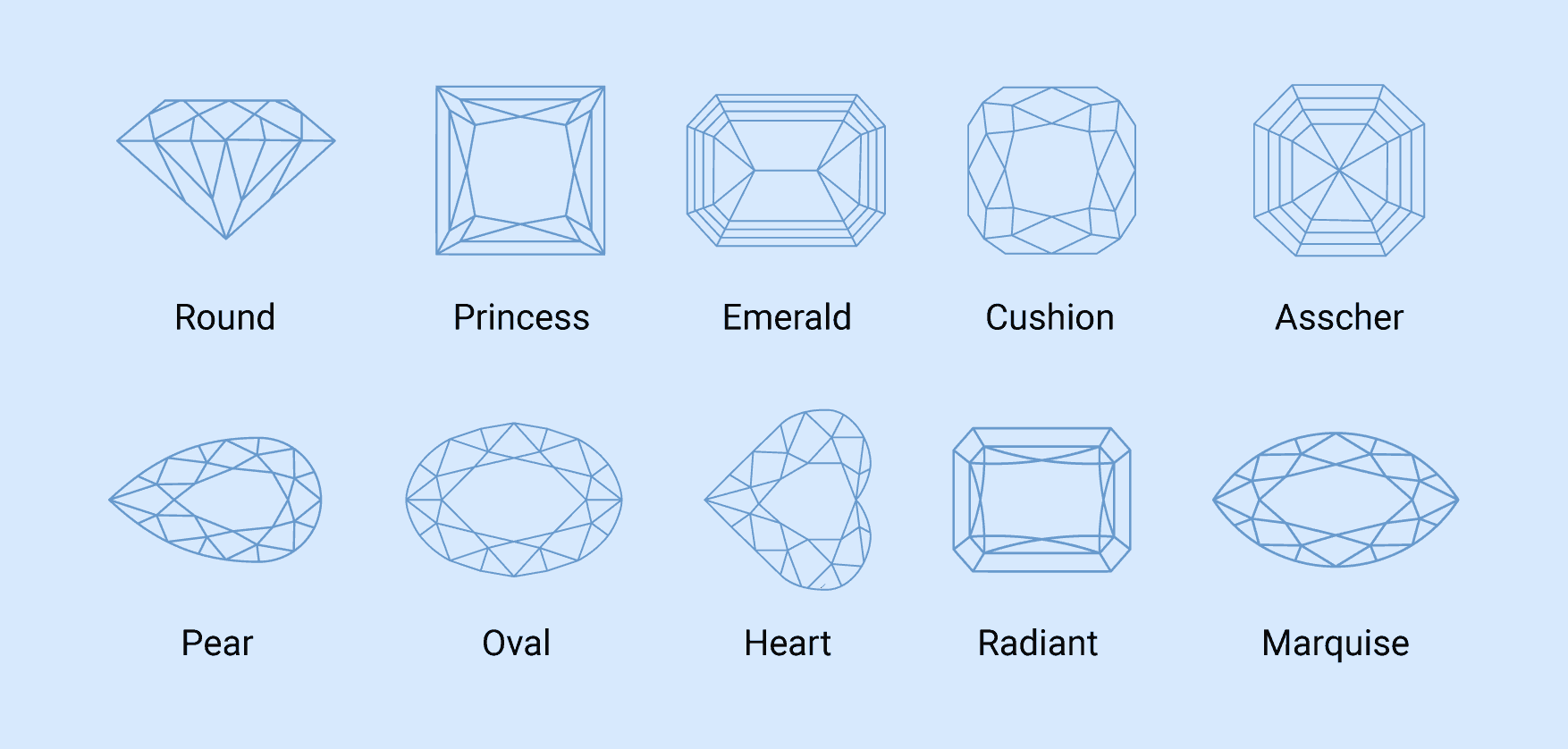
Asscher Cut vs. Princess Cut
Asscher and princess cuts share a similar, square-looking shape, which makes them comparable for many settings. There are some key differences, however, most notably that princess cuts are more brilliant due to the differences in how their facets are aligned.
Asscher vs. Princess: Shape
Both asscher and princess diamonds have a predominantly square shape, in that they have equal length and width. The main difference is the corners. Princess cuts have sharp, right-angled corners, making it a perfect square shape with four sides. Asscher cuts, on the other hand, have angled corners that make an octagonal shape – eight sides.
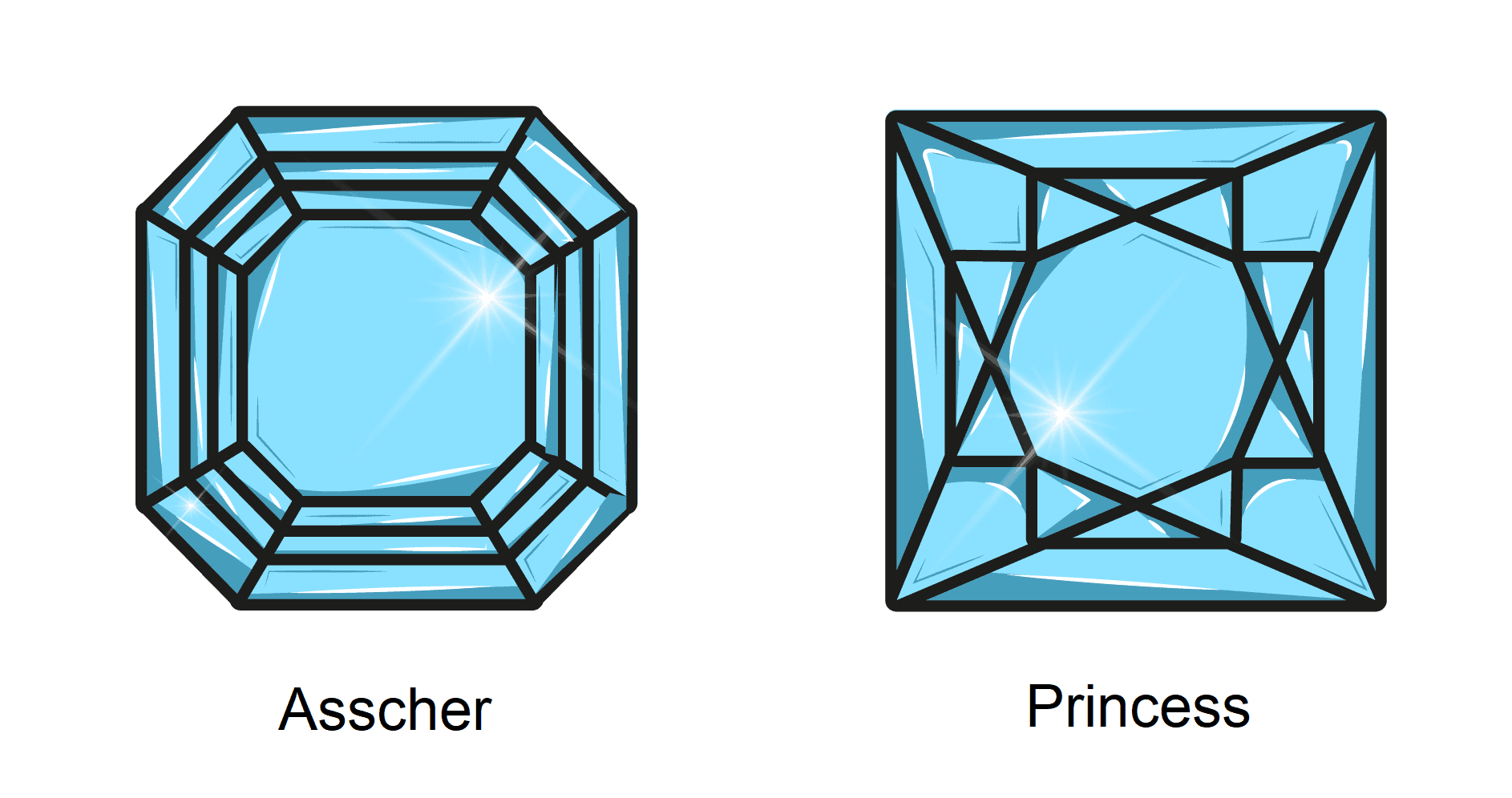
Asscher vs. Princess: Cut
The asscher cut and the princess cut belong to two different types of cut. Asscher cuts are “step cuts”, which have straight facets and a larger table size. It also has a deeper pavilion and higher crown. Princess cuts are “brilliant cuts”, which exhibits more fire and brilliance.
Brilliant diamonds such as princesses shine brighter than similarly graded step cuts. They also mask imperfections in clarity and yellowish tints better, meaning you can generally afford to go with slightly lower grades in a princess, compared to an asscher cut.
Asscher vs. Princess: Price
Carat for carat, asscher cuts are a little more affordable than princess cuts. This is because princess cuts of a similar grade has more brilliance than asscher cuts, therefore are more desirable. However, the price tends to even out in the end when you consider that you need to go up 1-2 grades in clarity for asscher cuts to get an eye-clean diamond.
Asscher Cut vs. Cushion Cut
Asscher cuts and cushion cuts both resemble a square (though rectangular cushions are very popular among people). The similarities in shape mean they can often be interchanged in many settings, depending on your preference. The main differences between these two diamond shapes are their corners and the way they reflect light.
Asscher vs. Cushion: Shape
The main difference in shape between asschers and cushions is in the corners. Asscher cuts are octagonal, with straight angles on each of the sides. Cushion cut diamonds have rounded corners. So while the outline may look the same from a distance, once you look close, you’ll notice the difference in shape.
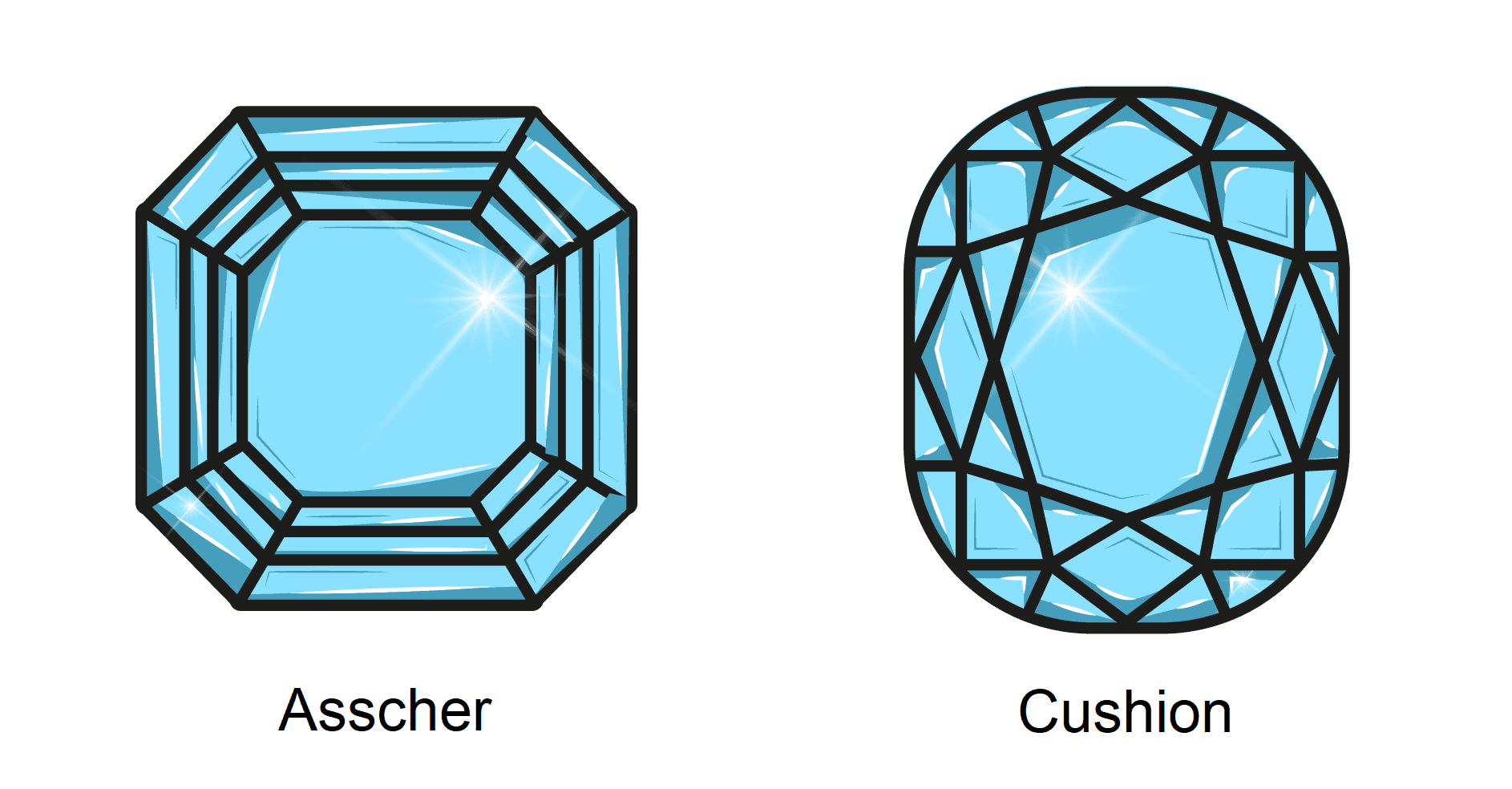
Asscher vs. Cushion: Cut
Cushion diamonds, like the princess cut, are brilliant cut diamonds. The difference in facets generates somewhat different reactions to light. The asscher cut offers slightly more brilliance (white light reflection) while the cushion cut provides more fire (colored light reflection).
Asscher vs. Cushion: Price
Both asschers and cushions are similar in price. Their similarities in shape mean you’re getting around the same visible size for your money (compared to an emerald cut, which appears bigger at the same carat weight). Cushion cuts may end up being slightly more affordable when you consider that asscher cuts require a higher grade in clarity to provide the same eye-clean appearance.
Overall, asscher and cushion cuts are fairly affordable diamond shapes, as a large amount of the rough stone is maintained when cutting the diamond. For this reason, they tend to be cheaper than round brilliant cuts, for example.
Asscher Cut vs. Emerald Cut
The difference between asscher and emerald cut diamonds is that asscher cuts are square while emerald cuts are rectangular. The asscher offers more sparkle, while the emerald cut tends to appear larger for the same carat weight.
Asscher vs. Emerald: Shape
The most important differentiating factor between asschers and emeralds is in the shape. Emeralds have a more elongated, rectangular shape. Most have a length-to-width ratio somewhere between 1.30 and 1.50.
Asscher cuts, however, have a predominantly square shape, with even length and width. The shape is actually octagonal, with the corners slanted (as opposed to sharp corners of a perfect square).
Whichever shape is “better” is totally down to personal preference. Some will prefer the shape of an Emerald, which gives a similar look and feel to other elongated shapes like oval, pear and marquise diamonds. Yet others may opt for the more traditional shape the asscher brings.
It is worth noting that the longer shape of emerald cuts gives a larger surface area, meaning an emerald will appear larger than an asscher of similar carat weight. The asscher, though, will give a brighter sparkle than a similarly graded emerald.
Asscher vs. Emerald: Cut
Emerald and asscher cuts are a class of diamond cuts that are known as “step cuts.” According to Wikipedia step cuts are:
Stones whose outlines are either square or rectangular and whose facets are rectilinear and arranged parallel to the girdle are known as step- or trap-cut stones.
These stones often have their corners truncated, creating an emerald cut (after its most common application to emerald gemstones) with an octagonal outline.
This is done because sharp corners are points of weakness where a diamond may cleave or fracture. Instead of a culet, step-cut stones have a keel running the length of the pavilion terminus.
Because both the pavilion and crown are comparatively shallow, step cut stones are generally not as bright and never as fiery as brilliant cut stones, but rather accentuate a diamond’s clarity (as even the slightest flaw would be highly visible), whiteness, and lustre (and therefore good polish).
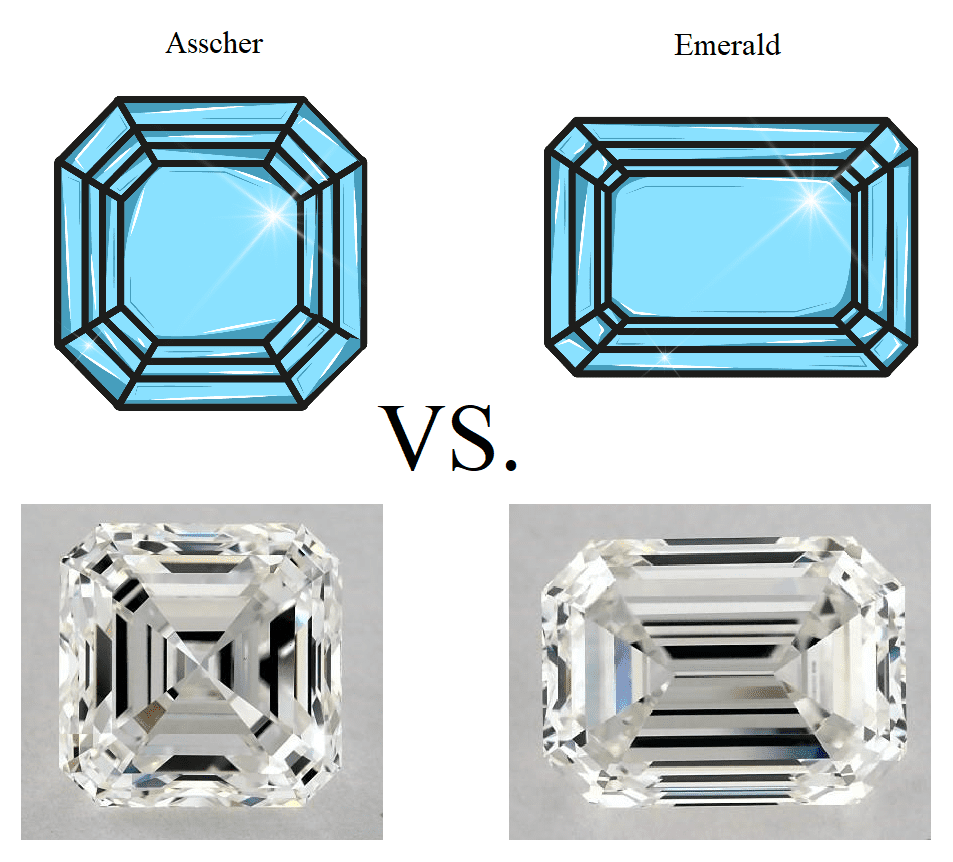
The way they are cut means asscher diamonds are more brilliant, and give off a more impressive sparkle. In comparison, emerald diamonds have a bigger visible appearance, but show off imperfections easier, meaning you’ll need to go a little higher in clarity when purchasing an emerald cut.
Both asscher and emerald cuts are excellent options, but it’s especially important that you purchase these cuts from a jeweler who can guarantee high-quality color and clarity.
Asscher vs Emerald: Price
Asscher and emerald cut diamonds are usually very similar in price. Both shapes are cheaper per-carat than round diamonds. However, as it’s easier to spot imperfections in step-cuts like asschers and emeralds, you may end up spending more for a higher clarity grade, which makes up for the more affordable diamond price per carat.
When we’re comparing asscher and emeralds, however, price is not going to be a factor. Instead, it comes down to your preference in shape.
To see if you like the look of an asscher cut, you can peruse recently purchased rings from our highest-rated retailers here.
Is Asscher Cut More Expensive?
Asscher cuts are not more expensive than most diamond shapes, as they have a relatively low price per carat. The majority of the rough stone is maintained in the cutting process, keeping the costs low.
The price of asscher cuts depends on factors like cut quality, color and clarity. For a 1 carat asscher cut with G-H color and VS2 clarity, the average price is $3,600. This 1 carat asscher cut from Blue Nile is a beautiful example priced at $3,030. For a 2 carat asscher cut with G-H color and VS2 clarity, the average price is $14,819.
How do you pick an Asscher Cut diamond?
To choose the most beautiful asscher cut for your budget, consider expert recommendations for color, clarity, and cut quality. Opt for the grade that gives you the desired appearance without overpaying. You’ll also want to look at each diamond closely before purchase.
Follow the recommendations above and reach out to our experts for specific questions.
Asscher Cut Diamond – Color
When it comes to color, you need to be a slightly more careful with an asscher or emerald cut than you would with a round Brilliant or even a princess cut. Round brilliants and princess cuts are brilliant cuts, therefore they both do quite well at masking the color of the diamond’s rough material.
Asscher cuts and emerald cuts, on the other hand, have no brilliance. They are cut for their clarity and luster – so nothing is hidden. Because of this, I recommend when buying an emerald or asscher cut that you buy a minimum of an H color.
Matching Colors
A G or higher color will definitely provide you with some incremental whiteness, but the visual difference is so slight that it might not be worth the added premium.
It is important to remember, however, that if you are buying an emerald or asscher cut for an asscher cut engagement ring or an emerald cut engagement ring, then you need to make sure the color of your center diamond matches the color of the side stones.
Our Color Recommendation
I color or better. I color with an asscher or emerald cut diamond will give you the best value. Going higher in diamond color will give you an incremental benefit, but I’m not convinced it’s worth the incremental price.
I don’t recommend J color with asscher or emerald cuts because they retain color slightly more than round brilliants and princess cuts.
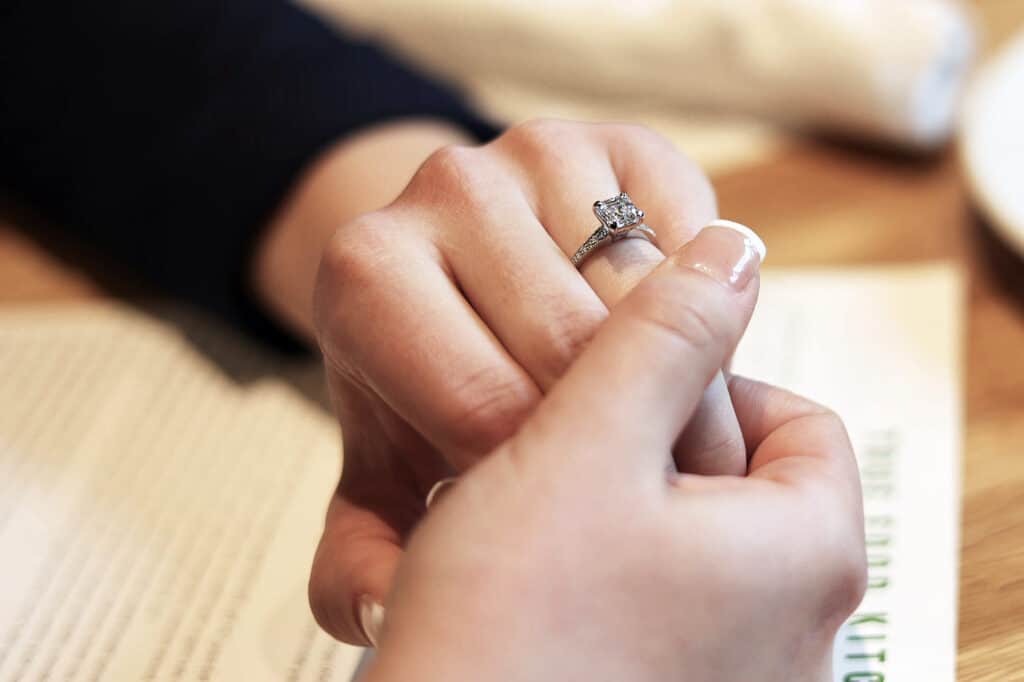
Asscher Cut Diamond – Clarity
It is specifically regarding clarity that emerald and asscher cuts are most distinguished from the other diamond shapes. The other shapes, known as a category as “brilliant” cuts, all chop up the incoming and outgoing light in endless ways due to the unique faceting of each shape.
This effect provides the sparkle and fire we all know and love about diamonds. But aside from it providing great visual fireworks, it’s also a very effective way to hide impurities inside a diamond.
Emerald and asscher cuts, on the other hand, are step cuts. They provide no fire or sparkle. Their beauty lies in showing off the simple beauty of a clean and sharp gemstone.
VS2 Clarity Inclusions on Emerald and Asscher Cut
VS2 clarity inclusions which would almost never be seen in a round diamond can easily be seen floating inside of an emerald or asscher cut.
Once in a while, you can find an SI1 graded emerald or asscher cut that is still clean to the naked eye, if the inclusion is contained completely on the side underneath the step facets.
The table of an emerald cut or asscher cut is like a big clear unobstructed window into the center of the stone. Almost any inclusions there will be clearly visible. If you’re looking for an SI1 or SI2 asscher or emerald cut, then you must verify that the inclusion is not in the center of the stone.
You can accomplish this online with James Allen’s Virtual Loupe.
But for the most part, I recommend people buy VS2 clarity or better.
Our Clarity Recommendation
Stick to VS2 clarity for the best value. SI2 and SI1 clarity grades are generally not recommended with step cuts such as asscher cuts and emerald cuts. Step cuts aren’t cut for their brilliance, so there’s no break up of light to hide inclusions. Take advantage of James Allen’s ultra-high-quality diamond photography to confirm your choice is eye clean.
Asscher Cut Diamond – Cut Quality
| Excellent | Very Good | Good | Fair | Poor | |
|---|---|---|---|---|---|
| Table % | Under 69 | 70-72 | 73-74 | 75-79 | >79 |
| Depth % | 61-67 | 59-60.9 or 67.1-70 | 57-58.9 or 70.1-74 | 54-56.9 or 74.1-79 | <54 or >79 |
| Girdle | Very Thin – Slightly Thick | Very Thin – Thick | Very Thin – Very Thick | Extra Thin – Extra Thick | |
| Cutlet | None | Very Small | Small | Medium | >Medium |
| Length/Width Ratio | 1.00-1.05 | 1.06-1.08 | >1.08 |
As with princess cuts, there’s no easy solution to buying an emerald or asscher cut with a great cut. With rounds, it’s easy.
GIA tells you their opinion, and you can trust it. With emerald and asscher cuts, though, you’re pretty much on your own.
GIA only grades polish and symmetry on fancy shapes. Unlike rounds, there’s really no industry-wide consensus on what parameters make up the perfect asscher & emerald cut.
The Lower the Total Depth, the Better
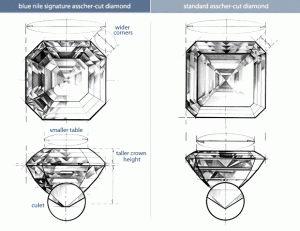
Look for a total depth between 60% and 68%. Generally lower is better. With the brilliant cuts, the depth is much more important because it has a crucial impact on how well the light is refracted inside the diamond.
Since emerald & asscher cut diamonds are step cuts, they don’t have this issue. Since you don’t need any built-up depth to maintain brilliance, you should go as low as possible in terms of depth.
Remember – a more shallow diamond means a diamond that will look larger. For table percentage, I recommend staying under 68%.
Our Cut Recommendation
- Depth: 60% to 68% (under 65% is relatively hard to find)
- Table: 60% to 68%
- Polish/Symmetry: Good, Very Good, or Excellent
- Length/Width Ratio:
- Asscher: 1.00 to 1.05 is GIA’s acceptable range for defining a diamond as “square.”
- Emerald: 1.25-1.55
Best Setting for Asscher Cut Diamond
The best setting for an asscher cut diamond is a solitaire, because it makes the unique design of the asscher cut stand out. Asscher cut engagement rings are available in white gold, rose gold, yellow gold, and platinum.
Here are a few examples of the best settings for asscher cut diamonds:
FAQs About Asscher Cut Diamonds
Here are the answers to the most common questions about Asscher Cut diamond rings.
Asscher cut diamonds sparkle due to their layered facets, high crown, and deep pavilion. The brilliance isn’t as strong as it is with rounds or princess cuts, but it’s still a gorgeous diamond. Asscher cuts tend to sparkle more than emerald cuts. The best way to choose an asscher cut with more sparkle is to carefully consider cut quality. We offer Asscher cut parameter recommendations above.
The difference between asscher cuts and Royal asscher cuts is that asscher cuts have 58 facets while the Royal asscher cut features 74 facets. The Royal asscher also has a higher crown. The original asscher cut was never patented and is the universal design for asscher cut diamonds. Both cuts were designed by the Royal asscher company.
The difference between an asscher cut and a radiant cut is that the asscher has eight sides, while the radiant cut only has four. The asscher cut also has step cuts, while the radiant does not. Radiants feature numerous facets and angles, making them appear almost like cracked ice. The radiant cut—second only to the round brilliant—offers more brilliance than the asscher cut. Because of less brilliance, asscher cuts are usually less expensive than radiants.
Shop for asscher cut diamond engagement rings here.
Here are more specific diamond shape topics to browse:
- What are the best diamond shapes/cuts?
- What is the most affordable diamond cut/shape?
- What is a round brilliant cut diamond (grade, clarity, and price)?
- What is a princess cut diamond (grade, clarity, and price)?
- What is a cushion cut diamond (grade, clarity, and price)?
- What is the price of an oval-cut diamond?
- What is a pear-shaped diamond vs. a round-shaped diamond?
- What is an emerald-cut diamond (grade, clarity, and price)?
- What is a radiant-cut diamond (grade, clarity, and price)?
- What is a marquise-cut diamond (grade, clarity, and price)?
- What is the price of a heart-shaped diamond?

- No questions asked returns within 30 days of shipment. James Allen will send you a paid shipping label to return the ring.
- Lifetime Warranty
- Free International Shipping
- Free prong tightening, repolishing, rhodium plating and cleaning every 6 months
- Provide insurance appraisals
- One free resizing within 60 days of purchase
- Free ring inscriptions
- Best-in-class high quality imagery of all diamonds in stock
- 24/7 Customer Service
- Best-in-class packaging


- No questions asked returns within 30 days of shipment. Blue Nile will send you a paid shipping label to return the ring.
- Lifetime Warranty
- Free Shipping
- Free prong tightening, repolishing, rhodium plating and cleaning every 6 months
- Provide insurance appraisal
- One free resizing within the first year of purchase
- High quality images of about half of their diamonds
- 24/7 Customer Service
- 100% credit towards future upgrades (must be at least double in value)
- Best in class fulfillment

Still afraid of getting ripped off?
Before you buy a diamond, get personal buying advice from industry veterans. We'll help you get the best diamond for the money.
Ask your diamond purchase question here
DISCLAIMER: We don't use your email for marketing. Period.
You Might Like
Diamond Prices: A Complete Guide
A diamonds’ price is determined primarily by the 4 Cs of the diamond. On the wholesale level, diamond prices are first based on a diamond shape and
The Best Places to Buy Engagement Rings
Buying an engagement ring is often one of the first major purchases in a person's life. The process can be fraught with tension as there are so m
1 Carat Diamond Price & Buying Guide
A wide range of 1 carat diamonds exist both in online markets and local diamond jewelry stores. Not only are there significant differences in beauty

